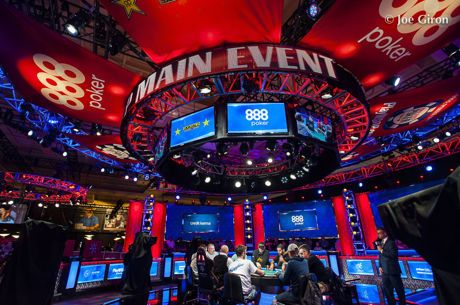Why Not Shove? Going All in When Acting First to Negate Positional Disadvantage

Position has its advantages, but you shouldn't let being first to act hinder your progress more than necessary.
It almost goes without saying, but in no-limit hold'em being first to act means you can always be the first to go all in. And this can be a powerful diminishment of the power of position.
What follows is an online hand demonstrating that very idea.
Preflop and Position
In a game of six-handed 100NL ($0.50/$1), the player under the gun with $215 to start raised to $3. Two players called — the cutoff and the button — meaning that no matter the opponent, the UTG player would be out of position for the remainder of the hand.
The button, who would turn out to the the principal opponent in the hand, was a recreational player enjoying a wrecking ball of a session, playing a stack of $375.
The Flop, or Bets on Bets on Bets
The flop came 10♣7♦4♣, and our intrepid initial raiser ventured forth with a bet of $7 into $10. The frankly irrelevant cutoff player ducked out of the way, then the button, feeling full of momentum, raised it up to a rather cheeky $18.99.
In this spot with deep stacks and position against him, the initial raiser should consider reraising with hands he might not otherwise, and folding with ones he might usually continue. The UTG player did raise — substantially enough to $47. The excitement did not stop there, as the button called.
Consider the hands the button would call with here. Gutshots and straight draws, flush draws and sets. Maybe pocket jacks or the odd ace-ten.
Would not the initial raiser wanted to punish all these hands a bit more strongly with a larger bet size? Going into the turn there was still $165 behind and the pot was only $104. If under the gun were going to go with two aces, or whatever hand he thought good enough to go with, had he reraised larger on the flop — say to $57 — he would have charged a hand like 8x6x more to take a card off and could have shoved for less a ratio of the pot on the turn.
It is so rare to solicit a flop four-bet in a circumstance such as this from a hand that would not have otherwise. What I mean by that is that, if the in-position player was going to four-bet the flop with 7x7x, he would do it against either $47 or $57. But there are very few hands, and very few instances, where someone with Jx9x is going to call a flop three-bet or fold, but decide on the basis of the sizing to $47 to go for the four-bet as a maniacal semi-bluff.
So really, absent an incredibly specific read, raising to $57 here would be better than $47 almost irrespective of one's hand.
Turn Problems and Solutions
The turn card was the 9♦, making the board 10♣7♦4♣9♦ and elevating the backdoor flush draw to the frontdoor's equal.
If the button had made a raise with Jx8x or 8x6x to take the price on the reraise, he just drilled the turn. Otherwise, a spooked underset like 4x4x or 7x7x has to be worried about how the board is developing. If he raised a draw like Q♦J♦ or Q♣J♣, he's turned a massive amount of equity. This turn card will almost never diminish the button's hand enough that he'll want to surrender the pot — if anything, the opposite.
Meanwhile the man out of position has a range, and whatever that range is, he has a problem to go with it. Again, there is $104 in the pot and $165 behind. If he has a set, he wants all the money in now. If he has a nut flush draw or a flush draw with a gutshot or double-gutshot, and he bets half-pot, he risks getting shoved on and having to call off with no fold equity and no hand with one card to come. Or he could fold double-digit outs.
I guess the headline and introduction kind of gives the solution away. Whether the flop three-bettor has a value hand (like 10x10x, 7x7x, or 8x6x) or a semi-bluff (like Q♦J♦, A♣8♣, or K♣Q♣), he should shove. He has two ranges on this turn: shoving and check-folding. Problem solved.
What Happened
The under-the-gun player didn't shove. He bet $61, leaving $104 back. The player in position used it (just the thing a shove manages to avoid!) and called. Think of how many bad cards could come!
One did. It was the 6♦, making the final board 10♣7♦4♣9♦6♦. So the backdoor flush came in and any straight draw with an 8x completed. Even 5x3x got there.
The flop three-bettor, once bold and heroic, felt lost in this world and pushed the rest of his money into the pot with 10x10x. The recreational player's session from heaven continued — he called with 9♣8♠.
Conclusion
The thing about shoving a range of made hands and big draws on the turn is not just that under the gun will avoid making any mistakes on the river. Even better than that, our button recreational player cannot make a winning decision.
He can't fold 4x4x, since he is ahead too often, even though he is dead facing six combinations of 7x7x and 10x10x. They can't call 9x8x so easily either, even with a pair and eight outs to a straight.
Instead, under the gun made a decision that put himself in an impossible river situation. It isn't just this particular river card — it's any diamond, any club, any six, eight, jack, five, even a three, queen, or king.
There is no rule against betting more than pot, particularly when out of position. Instead of playing a game called "bad or worse?" with yourself, shoving ends the game then and there.









